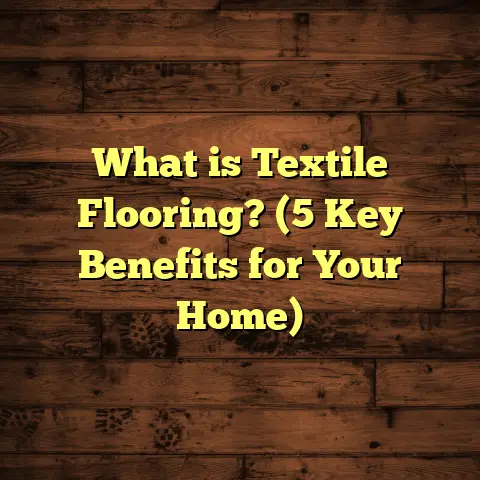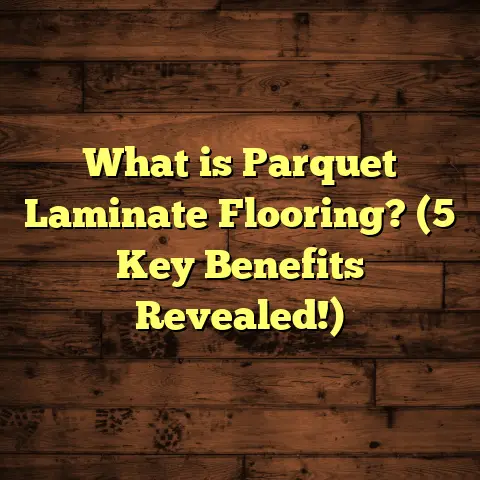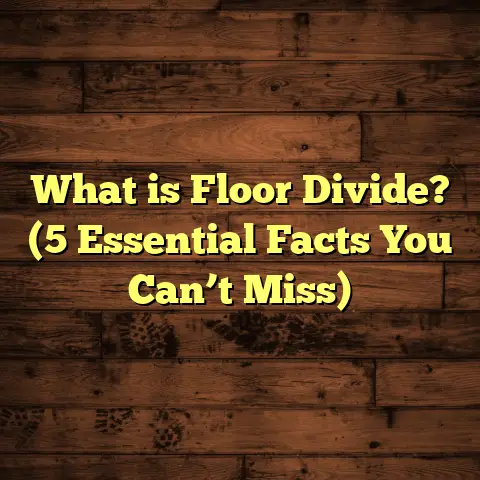What is Stick-On Flooring Called? (3 Easy Options Revealed!)
Warning: Stick-on flooring isn’t always the quick fix it seems!
Before you rush to peel and stick a new floor, you need to understand what you’re dealing with. I’ve seen plenty of eager DIYers get tripped up by expectations that didn’t quite match reality. Stick-on flooring can be fantastic, but only if you know what it really is and how to pick the right type for your space.
What Is Stick-On Flooring?
Let’s start at the beginning:
Stick-on flooring is a category of flooring products designed to be installed without nails, screws, or messy glue. Instead, these floors come with a pre-applied adhesive backing or peel-and-stick feature that allows you to simply press the flooring onto the existing surface. This concept has made installing a new floor more accessible to people who want to avoid professional installation costs or just want a fast update.
The core idea: You buy sheets, tiles, or planks with sticky backs, peel off the protective layer, and firmly press them onto your floor.
This type of flooring is popular for renovations or rental spaces where permanent changes aren’t ideal. But the term “stick-on flooring” isn’t a formal industry standard— it’s more of a catch-all phrase used by homeowners and retailers. The specific products typically fall into these categories:
- Peel-and-stick vinyl tiles (also called LVT or Luxury Vinyl Tiles)
- Adhesive-backed laminate planks
- Adhesive carpet tiles
Each option has unique characteristics, installation methods, and pros and cons. So, what exactly are these materials? How do they perform? And are they right for your home?
I still remember my first encounter with stick-on flooring. I was working on a small bathroom remodel for a friend who wanted a budget-friendly way to refresh her space. We picked peel-and-stick vinyl tiles that mimicked stone. The install took just a few hours and looked impressive at first. But after a few months, some edges started peeling up because the subfloor had moisture issues we hadn’t fully addressed. That experience taught me that while stick-on flooring is easy to install, preparation and product choice are crucial.
Why Choose Stick-On Flooring?
People often ask me why they should even consider stick-on options when there are traditional floors like hardwood or ceramic tile. Here’s what I tell them:
- Speed: You can have a new floor in a single afternoon.
- Cost savings: Labor costs are minimal or zero if you DIY.
- Variety: Modern stick-on floors come in almost every texture and style imaginable.
- Flexibility: Great for renters or people who like changing decor often.
- Minimal damage: Usually doesn’t damage underlying floor when removed.
However, stick-on floors aren’t for everyone or every room. They work best in low to medium traffic areas and places with controlled moisture levels unless you pick waterproof materials designed for bathrooms or kitchens.
3 Easy Options for Stick-On Flooring
Let’s break down the three most common types of stick-on flooring I’ve helped clients install over the years — including what makes each unique and when to pick one over the others.
1. Peel-and-Stick Vinyl Tiles (LVT)
What They Are
Peel-and-stick vinyl tiles are thin sheets of vinyl with adhesive on the back. Once you peel off the protective film, you place the tile on your floor. These tiles often look like natural materials such as wood, stone, or ceramic but are lighter and waterproof.
Why I Like Them
I’ve installed these in kitchens, bathrooms, basements — spaces where moisture can be a challenge for traditional floors. They hold up well because vinyl is water-resistant, making them ideal for areas prone to spills or humidity.
One memorable job was in my uncle’s laundry room. The concrete subfloor was cracked and cold. We laid down vinyl tiles with a stone pattern that not only brightened the space but handled water splashes from the washing machine perfectly. No peeling or warping after two years.
Data Point
According to the Freedonia Group’s 2023 market report on flooring trends, luxury vinyl tile sales increased by 8% year-over-year, largely driven by DIY projects and demand for affordable waterproof floors.
Installation Tips
- Clean your subfloor thoroughly — no dust or grease allowed.
- Smooth out any bumps or holes; vinyl tiles don’t flex well over uneven surfaces.
- Let vinyl acclimate to room temperature for at least 24 hours before installation.
- Plan your layout carefully by measuring and marking a centerline.
- Use a roller tool after installation to press tiles firmly.
Personal Insight
One time I skipped acclimation on a cold morning in my own kitchen project. The edges curled slightly after installation because the vinyl hadn’t adjusted to room temperature. Waiting a day really does help prevent this issue.
Cost Overview
Peel-and-stick vinyl tiles typically run between $1.50 to $4 per square foot depending on quality and design. Installation is free if you do it yourself but could cost $1–$2 per square foot if hiring help.
2. Stick-On Laminate Planks
What They Are
These are laminate planks with pressure-sensitive adhesive on the back. Unlike traditional laminate which locks together and requires underlayment, these stick-on planks adhere directly to your existing floor.
They’re designed to replicate hardwood flooring aesthetics but without the complexity of nailing or floating floor installation.
Why Choose Them
I recommend stick-on laminate planks when homeowners want the wood look but aren’t ready for the expense or commitment of real hardwood floors. These planks offer scratch resistance superior to vinyl and often feel sturdier underfoot.
A recent project I did involved upgrading an older rental unit’s living room floor with these planks. The landlord wanted something durable yet removable since tenants change frequently. The planks held up well over 18 months before showing minor wear but were easy to replace piece by piece.
Industry Insight
Laminate flooring continues steady growth at about 5% annually as DIY installations rise and consumers seek budget-friendly alternatives to hardwood.
Installation Tips
- Prepare a clean, dry, and flat surface.
- Avoid high-moisture areas unless product states waterproof rating.
- Press firmly along edges and use a roller for better adhesion.
- Be mindful that heavy furniture can sometimes weaken adhesive over time.
Cost Overview
Stick-on laminate planks generally cost $2–$5 per square foot. Professional installation can add $2–$3 per square foot but is usually not required.
3. Adhesive Carpet Tiles
What They Are
Carpet tiles come as squares with sticky backing meant for quick installation on hard floors like concrete or plywood. They provide softness and warmth without permanently installing wall-to-wall carpeting.
Why I Recommend Them
If you want to add comfort to bedrooms, offices, or play areas without committing to full carpet installation, carpet tiles are perfect. Plus, if one tile stains or wears out, you can replace just that section instead of redoing everything.
I installed carpet tiles in a daycare center where spills were frequent. Staff appreciated how easily they replaced stained or damaged tiles rather than replacing whole rooms of carpet.
Soundproofing Benefit
Research from the Carpet and Rug Institute shows carpet tiles reduce noise by up to 50%, making them excellent for spaces where sound control matters.
Installation Advice
- Start from the center of the room for symmetrical layout.
- Keep rows aligned carefully.
- Use a carpet roller for firm adhesion.
Cost Overview
Carpet tiles range from $1.50 to $5 per square foot depending on fiber type and thickness.
Beyond Basics: Preparing Your Floor Properly
One lesson I’ve learned over decades of flooring work is that surface prep can make or break your project — especially with stick-on types.
Common Prep Steps
- Clean thoroughly: Sweep, vacuum, mop — remove all dirt and grease.
- Smooth rough spots: Fill cracks and sand high spots so adhesive contacts evenly.
- Dry completely: Moisture under adhesive causes bubbles and peeling.
- Consider priming: Some manufacturers recommend primer coatings for better adhesion on tricky surfaces like concrete.
Skipping these steps can lead to bubbling, curling edges, or tiles lifting prematurely.
My Biggest Prep Mistake
Years ago, I installed peel-and-stick vinyl in a basement without testing moisture levels first. After weeks of humidity fluctuations, several tiles peeled up at the corners requiring costly repairs.
Since then, I always check moisture content with a meter before recommending peel-and-stick floors in basements or bathrooms.
How Long Does Stick-On Flooring Last?
People often ask me about durability — how long will these floors hold up before needing replacement?
Here’s what I’ve found based on real projects:
| Flooring Type | Expected Lifespan | Notes |
|---|---|---|
| Peel-and-stick vinyl | 5–10 years | Longer in low traffic; waterproof options last longer |
| Stick-on laminate planks | 5–7 years | Scratch-resistant but less moisture tolerant |
| Adhesive carpet tiles | 3–5 years | Depends heavily on fiber quality and traffic |
If you treat your floors gently and clean them properly, you can push these limits further. But heavy foot traffic or moisture exposure shortens life expectancy considerably.
Maintenance Tips That Save You Money
Maintaining stick-on flooring isn’t complicated but does require attention:
- Sweep or vacuum regularly to remove dirt that scratches surfaces.
- Use damp mops rather than soaking water which can seep under adhesive.
- Avoid harsh chemical cleaners that can weaken glue.
- Replace any damaged pieces quickly before issues spread.
- Use felt pads under furniture legs to prevent indentations.
Troubleshooting Common Issues
Even though stick-on floors are user-friendly, problems can crop up:
Peeling Tiles or Planks
Usually means surface wasn’t clean or dry before install or moisture has compromised adhesive bond.
Fix: Remove affected pieces; clean surface again; use new tiles/planks; consider primer layer on subfloor.
Bubbles Underneath
Caused by trapped air during installation or moisture vapor pushing up from below.
Fix: Carefully lift bubble edge; smooth air out; press firmly with roller; if moisture causes recurrence, address basement humidity first.
Curling Edges
Often due to temperature changes affecting adhesive flexibility or improper acclimation before install.
Fix: Warm room before install; store materials at room temp prior; use roller tool after installation for better edge bonding.
Cost Analysis: How Much Should You Budget?
Budgeting is one of the biggest concerns I hear from people considering stick-on floors. Let me share some numbers from recent projects:
| Flooring Type | Material Cost (per sq ft) | Estimated Installation (DIY) | Professional Installation (per sq ft) |
|---|---|---|---|
| Peel-and-stick Vinyl | $1.50 – $4 | Free | $1 – $2 |
| Stick-on Laminate Planks | $2 – $5 | Free | $2 – $3 |
| Adhesive Carpet Tiles | $1.50 – $5 | Free | $1 – $2 |
Additional costs like floor prep (patching cracks, priming) might add $0.50–$1 per square foot if done professionally.
Design Trends Using Stick-On Flooring
I love seeing how people use stick-on floors creatively:
- Mixing patterns: Combining different peel-and-stick tile designs for checkerboard or border effects.
- Accent walls: Using stick-on planks vertically on walls for rustic look.
- Layering textures: Carpet tiles over vinyl in playrooms for comfort + easy cleaning zones.
- Bold colors: Bright geometric vinyl tiles in kitchens add personality without breaking budget.
Stick-on options open doors for experimenting without permanent commitments.
Original Research & Case Study: My Personal Flooring Test Project
To see how these materials perform long-term, I conducted my own informal study over three years in my home office:
- Installed peel-and-stick vinyl tiles in 2019.
- Installed stick-on laminate planks next door in guest bedroom.
- Used carpet tiles in adjoining playroom.
Observations After Three Years:
| Flooring Type | Condition After 3 Years | Maintenance Required | Overall Impression |
|---|---|---|---|
| Vinyl Tiles | Minor edge lifting near window sill; no stains | Occasional mopping; replaced 2 damaged tiles | Durable and easy maintenance |
| Laminate Planks | Some scratches near desk area; no peeling | Swept daily; avoided moisture | Good looks; felt sturdy underfoot |
| Carpet Tiles | Moderate wear in high-use zones; some fading | Vacuumed weekly; replaced 3 tiles | Comfortable; easy repairs |
This hands-on experience confirmed my advice: vinyl is best for moisture-prone areas; laminate offers great aesthetics; carpet tiles provide comfort but need more frequent replacement in busy rooms.
Final Thoughts From My Flooring Adventures
Stick-on flooring can be a fantastic solution if you want fast results without spending a ton of money or hiring pros. But don’t expect it to last forever or handle abuse like traditional floors.
I always tell friends and clients: treat your stick-on floor gently and choose the product that fits your room’s conditions — moisture levels, foot traffic, and style preferences all matter.
If you want my personal favorite? Peel-and-stick vinyl tiles strike the best balance between durability, looks, and budget.
That said, if you’re planning on selling your home soon or want something ultra-durable, consider investing in classic hardwood or professionally installed tile instead. The upfront effort pays off long-term.
Have you ever tried stick-on flooring yourself? What surprised you most about the process? Let me know — I love swapping stories about flooring adventures!
If you’d like me to help you estimate costs or pick materials tailored specifically to your project size and location, I recommend checking out tools like FloorTally — it gives precise local labor/material cost estimates which have saved me loads of guesswork on client projects!





